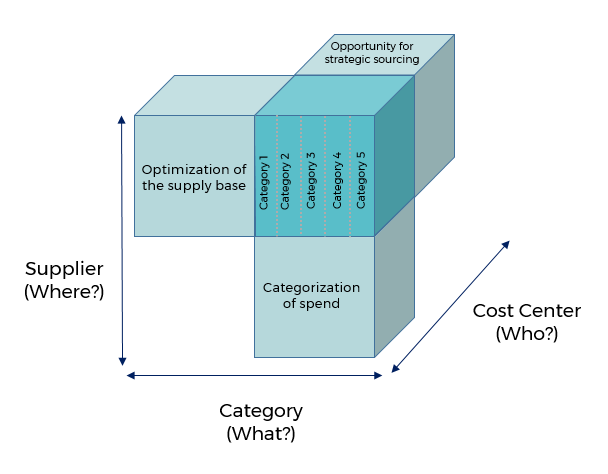Spend cube analysis is spend data presented as a multidimensional cube.
The three dimensions of a procurement spend cube are Suppliers, Corporate business units, and Category of item. The aim is to show who bought what from where.
It shows procurement spend data in three dimensions:
- Who? - the business units that you are buying for
- What? - the category of item or service that you are buying
- Where? - the suppliers you are buying from

Each axis of this cube contributes critical information for strategic sourcing decision-making. The data can be sliced and diced to provide the lowest level of detail on sourcing opportunities.
- Category analysis (X-axis) tells you what specific types of goods and services you are buying per supplier (from where) and for whom
- Supplier analysis (Y-axis) tells you the range of suppliers you are buying from per category (what) and per business unit
- Business unit analysis (Z-axis) reveals which cost center or end-users within your organization are buying (from where) and per category
Spend Cube in Excel vs. Spend Analytics
Spend cubes can be created using different sets of tools from Microsoft Excel to dedicated spend analytics software. The best choice for analysis depends on the resources, needs, and maturity of the procurement organization.
They can be done in Excel as an independent exercise by a procurement analyst or external consultant. For a simple analysis, procurement spend data can be exported and combined for analysis. The benefits of an Excel-based analysis are relatively quick speed and low cost.
For more mature and complex procurement organizations there are many spend cube analysis software options available. The benefits of using dedicated software for analysis include automated extraction of data, intelligent classification and enrichment of data from different sources, and advanced visualization options for data.
Read my top 6 learnings from 100+ Spend Cubes.
Purpose in procurement
Spend cubes provide insights that drive sourcing strategies. Focus can be directed to, for example, high-spend business units, suppliers that can be rationalized, or areas of spend that are not being actively managed by procurement. Some of the most useful analyses that indicate action are:
-
Contracted spend coverage
-
Tail spend management
-
Improving procure-to-pay (P2P) processes
-
Supplier relationship management
-
Opportunity to develop stronger and more strategic relationships with key suppliers
-
Increase the percentage of spend dedicated to strategic suppliers.
-
Reduce risk with sole-source suppliers
-
Category spend management
Benefits of analysis
Knowing where money has been spent is the starting point for making future sourcing decisions and making process improvements. The cube will tell you important information such as who your high-spend suppliers are and where most of the money paid out is going.
It can also tell you which areas of spend are growing and which are shrinking and where you have multiple suppliers for the same goods or services. However, spend cubes only identify where the money was spent, and once it is spent, it is non-recoverable.
Spend cubes are backward-looking. We need to look forward. Spend cube visibility highlights areas of opportunity, both for the short and longer term.
Here are six key benefits of spend cube analysis:
- Identify and achieve cost savings
- Data-driven category management
- Minimize maverick purchasing
- Rationalize supplier base
- Benchmark among business units
- Visibility to tail spend
Linking to savings opportunities
Multiple spend cubes can be created with a focus on one of the three different dimensions of spend. There is the opportunity for both finance and procurement to jointly identify opportunities and agree on the method of tracking savings and supplier performance.
The value is not the data itself: it is in the way that the data is leveraged to make decisions that drive greater value and improve performance.
A last word from Jason Busch of Spend Matters:
The future of spend analysis will rely on predictive intelligence that will recommend courses of action and drive a range of benefits, from better budgeting to forecasting commodity and supplier trends — and recommending associated strategies.



